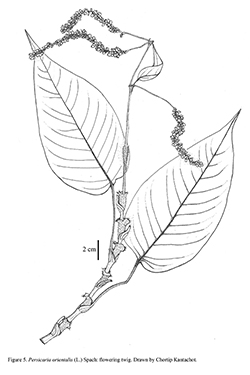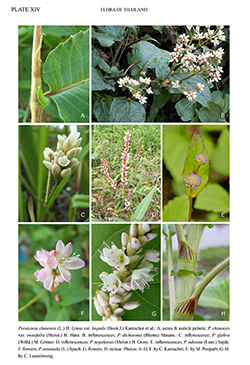e-Flora of Thailand
Volume 14 > Part 1 > Year 2018 > Page 139 > Polygonaceae > Persicaria
14. Persicaria orientalis (L.) Spachwfo-0000488434
Hist. Nat. Vég. 10: 537. 1841; Grierson & D.G.Long, Fl. Bhutan 1(1): 164. 1983; Munshi & Javeid, Syst. Stud. Polyg. Kashm. Himal. 62. 1986; Kantachot et al., Thai Forest Bull., Bot. 38: 143. 2010.— Polygonum orientale L., Sp. Pl. 1: 362. 1753; Meisn., Monogr. Polyg.: 53. 1826; Meisn. In Wall., Pl. Asiat. Rar. 3: 54. 1832; Meisn. In DC., Prodr. 14(1): 123. 1856; Hook.f., Fl. Brit. India 5: 23. 1886; Courchet, Fl. Indo-Chine [P.H.Lecomte et al.] 5: 37. 1910; Merr., Enum. Philipp. Fl. Pl. 2: 123. 1923; Steward, Contr. Gray Herb. 88: 40. 1930; K.Larsen, Dansk Bot. Arkiv 20(1–4): 53. 1961; Backer & Bakh.f., Fl. Java 1: 223. 1963; P.H.Hô, Câyco Việtnam 1(2): 946. 1991; Philcox in Dassan. & Clayton, Revis. Handb. Fl. Ceylon 11: 396. 1997; A.J.Li et al. in C.Y. Wu et al., Fl. China 5: 290. 2003; N.T.Do in Bân, Fl. Vietnam 11: 175. 2007. Fig. 5. Plate XIV: G–H.
Accepted Name : This is currently accepted.
Synonyms & Citations :
Description : Erect herbs; stem and branches terete, densely pubescent. Leaves with petioles (4.5–)5.2–7.8(–8.8) cm long; lamina (14–)17–26(–29) by (6.4–)7.5–9.5(–10.5) cm, ovate, pilose on both surfaces, base cordate-attenuate, apex cuspidate or cuspidate-mucronate, margin entire with pilose hairs throughout; secondary veins 16–19(–21)-paired, primary and secondary veins with densely pilose hairs on both surfaces. Ocreae cylindrical with foliaceous limb, (1.5–)1.8–2.2(–2.5) cm long, scarious, densely pubescent, venation inconspicuous, apex truncate or sometimes with pilose foliaceous limb, 4–7(–10) mm long. Inflorescences terminal and axillary, spicate panicle, (12–)18.2–32(–39.5) cm long, pendulous; inflorescence branches pilose; side branches (3.5–)6–11.2(–13.2) cm long, cylindrical or pyramidal, dense-flowered, rachis inconspicuous; leafy bracts absent or (1.5–)2–8(–14) by (0.4–)1–2(–4) cm long, ovate, apex cuspidate-mucronate, margin entire with pilose hairs. Flowers 4–7 in an ocreola; pedicels 2.8–3.5 mm long, glabrous; bracteoles 2.5–3 mm long, hyaline, with 2 veins; ocreolae completely enclosing rachis, (3–)3.5–4 mm long, moderately pubescent, without glandular dots, apex obtuse or acute, margin entire with hispid hairs. Tepals 5, pinkish or white; lobes 1.3–2(–2.5) by 1–1.5 mm, elliptic, apex obtuse, without glandular dots, veins 3 or sometimes inconspicuous; tube 1–1.2(–1.5) mm long, glandular nectaries 7. Stamens 7, in two whorls, outer ones 2–3 mm long, inner ones 1.8–3.2 mm long; anthers white or pinkish, elliptic or elliptic-oblong. Styles 2, 0.8–1.5(–2) mm long; stigmas capitate, white. Fruits with scarious perianth, lenticular, 2.2–2.7(–2.9) by (2.4–)2.6–3.1 mm, shiny black.
Thailand : NORTHERN: Chiang Mai, Chiang Rai, Phayao; NORTH-EASTERN: Nong Khai; SOUTH-WESTERN: Kanchanaburi; CENTRAL: Ang Thong; PENINSULAR: Phatthalung, Songkhla.
Distribution : Europe, Russia, India (type), Sri Lanka, Bhutan, Bangladesh, Myanmar, China, Taiwan, Korea, Vietnam, Cambodia, Java, the Philippines, Lesser Sunda island, Australia.
Ecology : Along river banks, roadsides and grassy fields, 0–500 m alt.
Vernacular : Phak phai nam (ผักไผ่น้ำ)(Northern); phak ueang (ผักเอื้อง)(Central).


